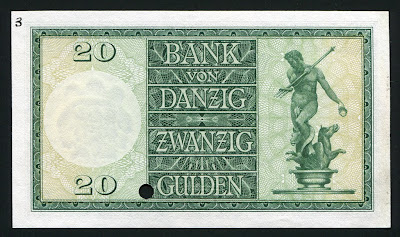 |
| Danzig banknotes 20 Gulden banknote of 1937, Artushof - Artus courtyard. |
 |
| Danzig banknotes 20 Gulden banknote of 1937, Neptune’s Fountain in Danzig |
Currency of Free City of Danzig (German: Freie Stadt Danzig; Polish: Wolne Miasto Gdańsk)
World Paper Money - Bank von Danzig - 20 Gulden banknote of 1937
Obverse: Artushof in Danzig (Artus courtyard)at center.Reverse: Neptune’s Fountain in Danzig (Gdansk), located in the center of Dlugi Targ, also known as The Long Market. Starting its living as a bronze statue in 1549; it was made into a fountain in 1633.
Danzig banknotes - Danzig paper money
Danzig 500 Gulden 1924 Danzig 1000 Gulden 1924
The Artus Court, formerly also Junkerhof (Polish: Dwór Artusa, German: Artushof) is a building in the centre of Gdańsk, Poland (German: Danzig), at Długi Targ 44, which used to be the meeting place of merchants and a centre of social life. Today it is a point of interest of numerous visitors and a branch of the Gdańsk History Museum.
Danzig gulden
The Gulden was the currency of Free City of Danzig (German: Freie Stadt Danzig; Polish: Wolne Miasto Gdańsk) between 1923 and 1939. It was divided into 100 Pfennige.Until 1923, Danzig used the German papiermark and issued several local 'emergency notes'. The Gulden was introduced at a value of 25 Gulden = 1 pound sterling.
Danzig was annexed by Nazi-Germany on 1 September 1939, the day the invasion of Poland had begun On the same day Reichsmark coins and notes were declared legal tender alongside the Danziger gulden, with 1 gulden being equal to 0.70 Reichsmark. This was a favourable exchange rate for inhabitants of Danzig, since the actual exchange rate was around 0.47 Reichsmark per gulden. To prevent abuse on 7 September the import of gulden coins and notes into the territory of the former free city was prohibited. Bank assets were however converted at the market rate of 0,47 reichsmark per gulden.
Effective 7 September 1939 coins of 1 and 2 pfennig became legal tender throughout Nazi-Germany as 1 and 2 reichspfennig and would remain in circulation until November 1940. On 30 September the reichsmark became the sole currency on the territory of the former free city. Notes and coins of 5 and 10 gulden were withdrawn that day and could be exchanged for reichsmarks until 15 October. Coins of 5 and 10 pfennig and ½ and 1 gulden remanined in circulation until 25 June 1940 and were redeemded until 25 July.
Coins
A first series of coins was issued in 1923, followed by a second in 1932. Coins were issued in denominations of 1, 2, 5 and 10 Pfennige and ½, 1, 2, 5, 10 and 25 Gulden.
Banknotes
Banknotes were issued in denominations of 1, 2, 5, 10, 25 and 50 Pfennige and 1, 2, 5, 10, 20, 25, 50, 100, 500 and 1,000 Gulden.